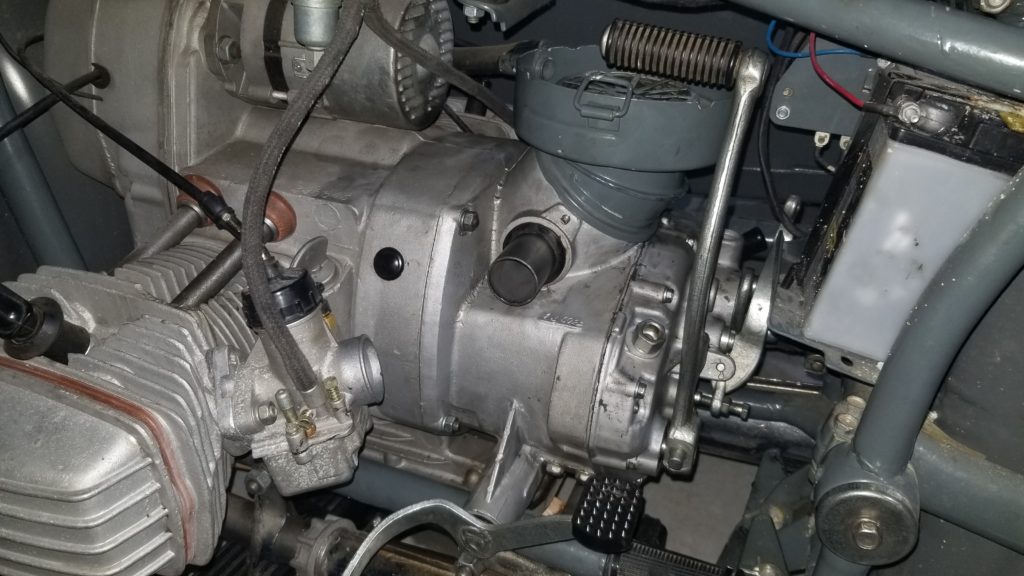Sometimes you meet people in unexpected ways. When my brother Daryl mentioned that his friend had a Russian sidecar motorcycle at his auto repair shop, I stopped in to look at it. It turned out to be a Dnepr, similar to my own in many ways, but decked out in military-style equipment and paint. The odometer showed one kilometer on it, so I assumed that this machine, like so many, was purchased online and shipped as-is to the buyer. In these cases, the motorcycles tend not to be in road-ready condition. This one needed some transmission work, as the kick-starter wouldn’t operate.
The shop was very busy and there was little room for an odd item like a Russian motorcycle, so it sat in the yard outside under a tarp. I told the shop owner that if he didn’t want to mess with it, he could feel free to give my phone number to the bike’s owner and that I’d be happy to see what I could do.
A few weeks later I got that call, from a friendly fellow named Russ. He said that he’d really appreciate any assistance I could provide. I learned that Russ lived less than 6 miles from my home, so I hooked up the trailer and fetched the bike. I thought it would be easier to work on it in my garage, where I have access to my tools and the motorcycle jack.
I finally got time to assess the situation Saturday. I had to remove the transmission so that I could disassemble it, so that required the rear wheel and shaft drive assembly to come out. These are simple machines, so that only took a few minutes. The transmission came out easily, being held in place by just 3 nuts and one bolt.
When I opened the transmission, I noticed that the shafts would only rotate halfway before binding. The shift forks were not in their correct positions. It only took a few minutes to remove all the gears and shafts. I inspected each piece then reassembled the unit. The shafts turned nicely, so I closed the transmission and mounted it on the engine. The engine, transmission and rear axle housing all needed to have oil added – bikes are typically drained of all fluids before being shipped.
I had previously charged the battery, so I added some fuel to the tank. Very quickly the left carburetor started dripping fuel. The carburetor float was stuck, so I fixed that and the leak stopped. It only took a minute to coax the 650 cc engine to life. After a lengthy warm-up, it behaved a bit better and settled into a nice idle. I took the bike outside for a test-drive on the icy side streets to shift through the gears. The transmission shifted nicely, and the engine felt strong. These bikes need lengthy break-in periods, but for a young engine it sounded good.
I sent the owner a text asking if I could return the bike, then hauled it back to his home. I pointed out some of the notable features and idiosyncrasies of these motorcycles, and briefly recapped the quick repair. I walked through the starting procedure step-by-step, and it fired to life with a single kick. I did a quick ride down his frozen dirt road to demonstrate the bike. The owner was thrilled, although he opted to pass on riding it himself on the icy road. He asked what a small lever was for and I replied that it was the reverse gear shift. He said that the paperwork mentioned that no reverse existed on this bike, but I assured him that I reassembled the transmission with a reverse gear. I had not thought to test the reverse feature, so I restarted the bike, pulled in the clutch, then shifted the small lever. When I released the clutch, the bike eased backward and the owner was again happy. It shifted easily back to first then neutral. He rolled it into his garage, ready for nicer weather.
These bikes can be finicky, so I expect that I’ll see the machine again in the future. At least now the motorcycle sits ready to ride, with nearly 6 kilometers on the odometer.

Canvas tonneau cover for the sidecar 
Rear drive and drive shaft are removed 
Transmission and rear drive are out 
Transmission and rear wheel and shaft drive are removed 
Engine flywheel is exposed 
Flange on the transmission for winding the kick starter spring. 
Transmission at the start of disassembly 
Transmission is nearly back together 
Transmission is back on the motorcycle 
Rear wheel is back on and the bike is off the jack 
After several kilometers of test riding through the subdivision 
The Dnepr before hauling it back to the owner




